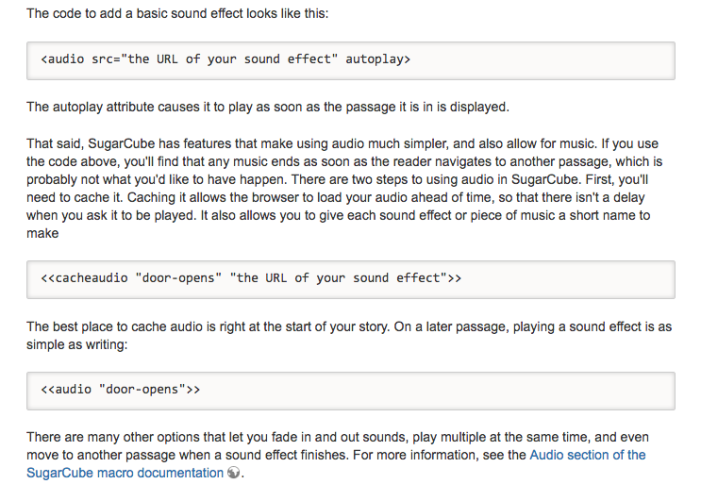Twine was definitely the right choice for me in the end. I progressed well with my story, easily connecting passages and bringing my idea to life. Timewise, I averaged an hour per chapter, and I wanted to include as much detail as possible with my story. Towards the end, however, I wasn’t able to invent a plot-twisting, never-saw-it-coming ending, so I settled on my second idea for the ending. This resulted in my last two chapters being quite shorter than my first two, and I’d originally intended for all my chapters to be of equal length. I don’t mind too much, as I conveyed my overall concept into Twine. I enjoyed working with Twine as it was incredibly easy to navigate through, and it suited my novice skill in coding overall.

Final story progression
There was, however, a slight issue I wasn’t able to overcome. Towards the end of my story, I wanted a specific song to play at a certain ‘option’ that the reader would choose. I researched on the Twine help guide to try and solve the issue, but I apparently needed Sugarcube to do so.

I had tried to enter in the code on Twine, and include the Youtube link of my song choice, but the text of that passage just showed up as regular text in the story, not an embedded code. After playing around for awhile, I decided that it wasn’t necessary to have the song in the background, so I scrapped the idea. Apart from that hiccup, everything turned out the way I wanted it to. If I had tried to continue with my Twitter bot, I most likely wouldn’t have gotten anywhere with it; or, I would have most likely have degressed in my progress.
Part of developing code literacy deals with the history and attitudes of code itself. Code was generally seen as this highly technical, complicated language that only geniuses could understand, and historically thought to be fit for men to understand whilst women were on the sidelines. In recognising what code today is, it’s important to appreciate the various, historical achievements in coding, as well as the people involved. Jennifer Light discussed the heavy involvement of women in major coding projects, like the ENIAC. During that time period, it’s interesting to note that women were “almost exclusively hired as computers”, as they were essentially the backbone behind the complicated coding and development of mathematical formulas (Light 1999, p. 474). During this era of automatically defaulting code as a “he” description, women were rarely recognised for their achievements in various projects; yet, women were working jobs equivalent to that of a computer (Light 1999, p. 474). Furthermore, the media failed to recognise women’s contributions to code technology. In this time, code was understood to be this revolutionary introduction to the next step in technology, and males could only solve it; however, code is understood today as this progressive technology that continues to connect society in various ways. It’s very refreshing and noteworthy to observe the changes of attitudes towards code from then. Code today is handled by both men and women, and just that statement alone demonstrates the positive development of code literacy, and brings about different perspectives to coding ideas/issues.
REFERENCES:
Light, J. S. 1999, ‘When Computers Were Women’, Technology and Culture, vol. 40, no. 3, pp. 455-483.